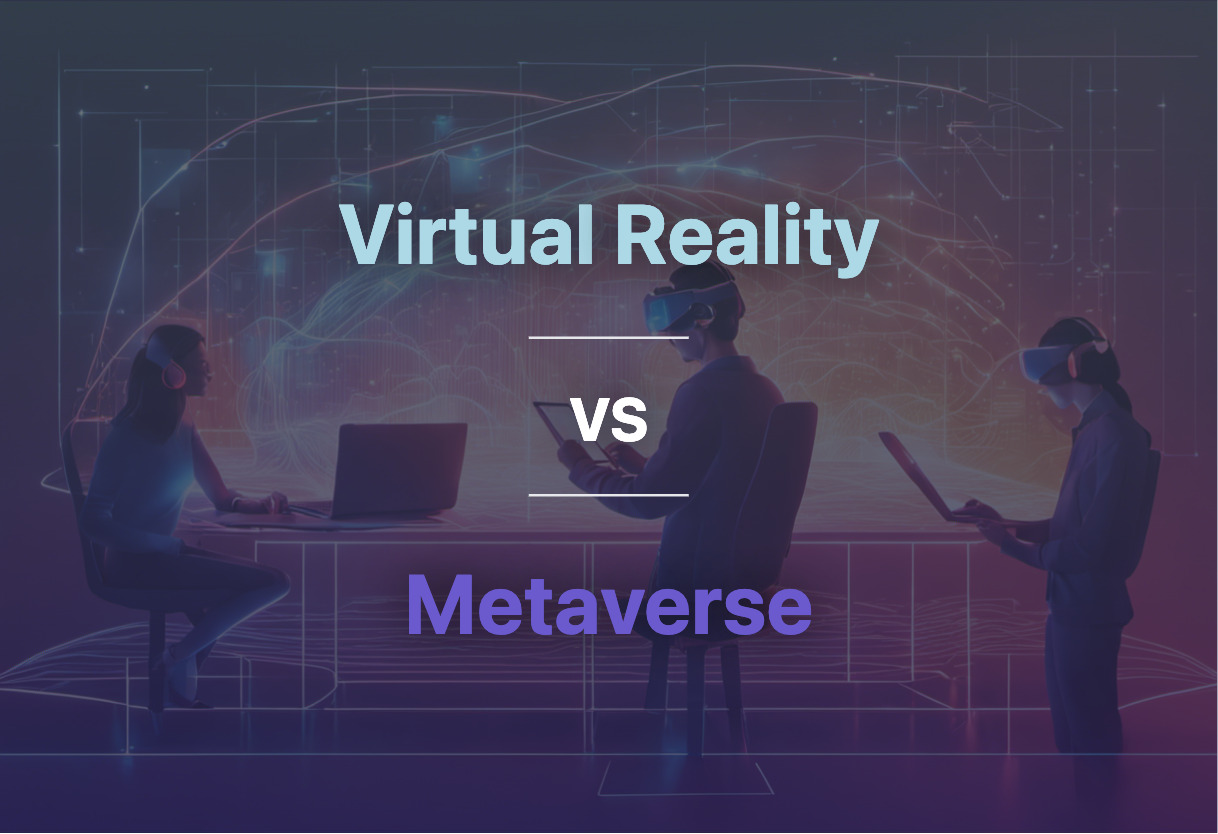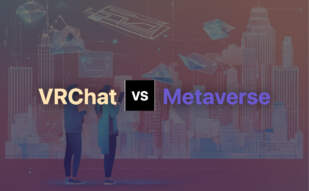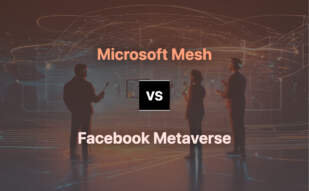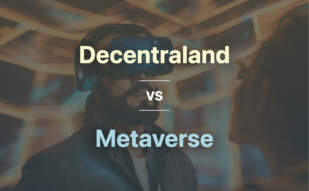In the debate of Virtual Reality vs Metaverse, VR is a mature, standalone technology with VR headsets offering immersive experiences. Conversely, the Metaverse represents a vast, collaborative, virtual environment amalgamating VR and other technologies. Software developers seeking focused, individual environment creation should favor VR, while those aiming at extensive, interoperable environments should gravitate towards the Metaverse.

Key Differences Between Virtual Reality and Metaverse
- VR’s inception predates 1800s, progressing through substantial evolutions while Metaverse is a recent concept, catalyzed extensively by Facebook’s rebranding to Meta.
- VR offers immersive 3D experiences through headsets whereas Metaverse conceives a collective virtual universe including VR and other technologies like AR, NFTs, and the blockchain.
- VR centers on individual environment creation, whereas Metaverse banks on building extensive, interoperable worlds, paving the path for shared virtual economies.
- VR market is dominated by few substantial players like Oculus, Sony whereas the Metaverse market is still in its nascent stage, likely to witness the entry of numerous tech firms and start-ups.
| Comparison | Virtual Reality | Metaverse |
|---|---|---|
| Concept Development | Roots traced back to 1800s. VR concept in Stanley Weinbaum’s Pygmalion’s Spectacles (1935). Sensorama by Morton Heilig (1956) and Ivan Sutherland’s “Ultimate Display” (1965) mark significant development milestones. | Concept of metaverse traces back to 1938 Antonin Artaud’s essays, but is more directly recognized in Neal Stephenson’s Snow Crash (1992). Facebook’s recent rebrand to Meta has amplified current Metaverse buzz. |
| First Immersive Device | First stereoscope in 1838. First modern-like device was the head-mounted display device, Telesphere Mask, patented in 1960 by Heilig. | Ivan Sutherland’s “Sword of Damocles” (1968) displayed digital wireframe graphics, important foundation for immersive online spaces. VPL Research developed the first commercial VR headset in 1984. |
| Key Developments | Oculus Rift prototype (2010) accelerated VR development, followed by Facebook’s $2 billion acquisition of Oculus VR in 2014. | Key proto-metaworlds like Active Worlds (1995) and Second Life (2003) paved the way for metaverse development, followed by Facebook’s parent company Meta’s massive $10 billion metaverse investment in 2021. |
| Purpose and Application | Initially used for immersive entertainment and remote viewing of hazardous military situations. Now also utilized for digitally simulating real-world environments for multiple industries. | Multi-dimensional space that integrates AR and VR experiences. Metaverse aims to provide immersive 3D worlds and harbors potential for harmonizing commerce and interoperability with Blockchain and NFTs. |
| Critical Enablers | Sensorama, Telesphere Mask, Ivan Sutherland’s “Ultimate Display” concept, Dimension International’s VR software, VPL’s DataGlove and EyePhone HMD. | Ethereum and Bitcoin, VR devices like Oculus, shared spaces like Second Life and Roblox, Microsoft’s Mesh, Siemens-Nvidia partnership, Fortinite’s virtual concert, NFTs and blockchain. |
What Is Oculus VR and Who’s It For?
Oculus VR is a technology company specializing in immersive virtual reality hardware and software products, renowned for pioneering the modern VR revolution. Aimed primarily at tech-enthusiasts, gamers, and forward-thinking professionals, Oculus VR is pushing boundaries in digital entertainment, social outreach, training, and distance learning.
Founded by Palmer Luckey, Oculus VR was catapulted to tech stardom when its prototype Rift gained high-profile endorsements and impending momentum, culminating in its acquisition by Facebook in 2014. This marked a significant phase in the commercialization of VR technology.

Pros of Oculus VR
- Offers an immersive VR experience with smooth motion tracking
- High-resolution display
- Supports a wide library of games and applications
- Facebook backing secures future development
Cons of Oculus VR
- Dependent on high-end PC for best experience
- Facebook account required
- Cables can hinder mobility
- Limited battery life on wireless models
What Is Meta and Who’s It For?
Meta, once known as Facebook, is a multinational technology corporation known for advancing the metaverse – a collective virtual shared space. Meta is designed for a wide audience that ranges from everyday social media users, digital artists and gamers, to businesses looking for remote collaboration and retail opportunities in a VR setting.
Meta is redefining the digital communication landscape by transitioning from its 2D social networking origins to developing an immersive, 3D internet experience. It plays a pioneering role in shaping our interconnected future in the Metaverse era. The rebrand to Meta in 2021 signifies the company’s pivot towards this ambitious vision.

Pros of Meta
- Pioneering role in developing the metaverse
- Significant resources for research and development
- Immersive 3D environments for work and play
- Integration of VR, AR, and social media platforms
Cons of Meta
- Concerns over user privacy and data security
- Over-reliance on VR and AR hardware
- Metaverse as a concept is still in its nascent stage
- Monopolistic tendencies may stifle innovation
Stering the Code-Laden Waters: Virtual Reality vs Metaverse
Two digital titans stand abreast in the realm of innovative technology: Virtual Reality (VR) and the Metaverse. Your gears are grinding, and you’re here to know which one claims dominance. Let’s dissect it for different audience segments:
Software Developers
Virtual Reality, boasting a rich heritage from the 1800s and advancements like the Oculus Rift, provides developers a stable, mature platform to build immersive experiences. However, for those keen on non-fungible tokens (NFTs) and blockchain, the Metaverse holds infinite potentials. Its intertwined commerce, 3D environments, and comprehensive digital experience opens a new universe to tame, expanding way beyond the boundaries of VR.

Game Designers
Knowledge of VR’s successful game implementations, like VR flight simulators, provides game designers a tried-and-tested game development platform. Yet, the Metaverse, with its gamified environment and experience-driven uniformity, presents an unparalleled opportunity to forge interactive, immersive landscapes like never before.

Business Enthusiasts
Business enthusiasts best suited to the Metaverse, offering a borderless digital marketplace interconnected with blockchain and NFTs. However, the sophistication of VR, like Sensorama’s multisensory simulations, offers profound potentials for enhancing customer experience and setting your brand apart.

In the tech-codenamed battle of Virtual Reality vs Metaverse, the verdict lands differently based on your needs. While Virtual Reality offers a mature platform with solid footing, the Metaverse represents an unchartered digital frontier pushing beyond current 3D limitations.
Grant Sullivan
Content writer @ Aircada and self proclaimed board game strategist by day, AI developer by night.





